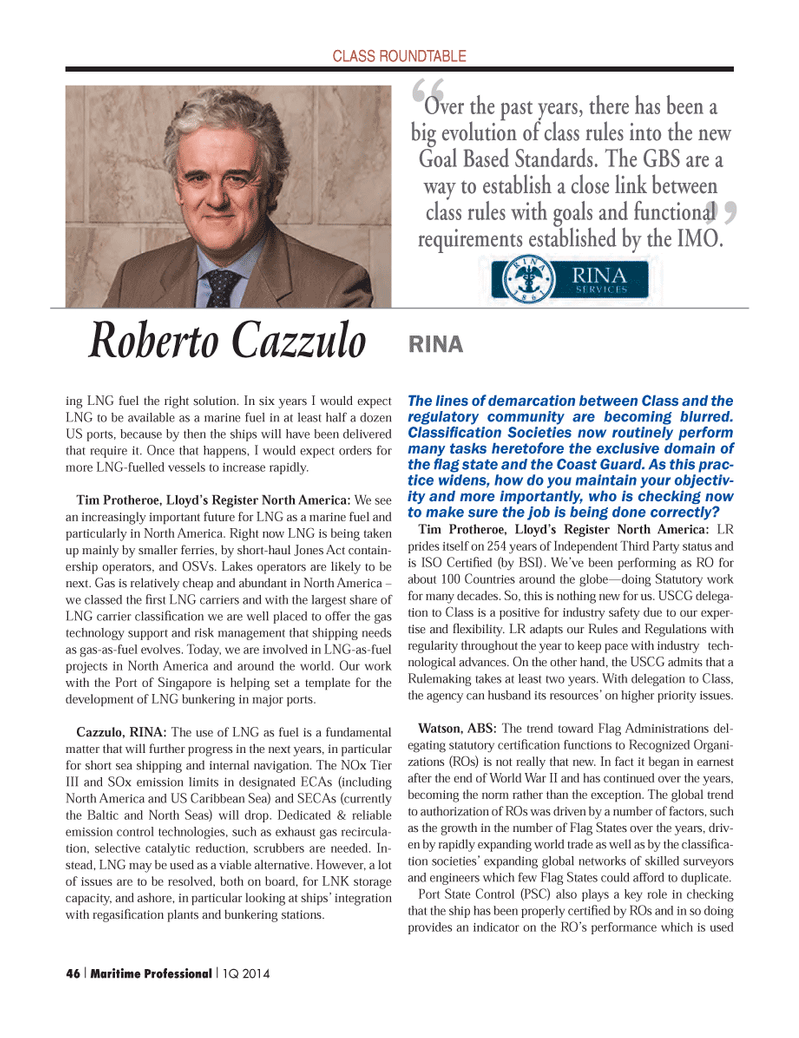
Page 46: of Maritime Logistics Professional Magazine (Q1 2014)
The Energy Edition: Exploration, Production & Transportation
Read this page in Pdf, Flash or Html5 edition of Q1 2014 Maritime Logistics Professional Magazine
CLASS ROUNDTABLE ing LNG fuel the right solution. In six years I would expect
LNG to be available as a marine fuel in at least half a dozen
US ports, because by then the ships will have been delivered that require it. Once that happens, I would expect orders for more LNG-fuelled vessels to increase rapidly.
Tim Protheroe, Lloyd’s Register North America: We see an increasingly important future for LNG as a marine fuel and particularly in North America. Right now LNG is being taken up mainly by smaller ferries, by short-haul Jones Act contain- ership operators, and OSVs. Lakes operators are likely to be next. Gas is relatively cheap and abundant in North America – we classed the fi rst LNG carriers and with the largest share of
LNG carrier classifi cation we are well placed to offer the gas technology support and risk management that shipping needs as gas-as-fuel evolves. Today, we are involved in LNG-as-fuel projects in North America and around the world. Our work with the Port of Singapore is helping set a template for the development of LNG bunkering in major ports.
Cazzulo, RINA: The use of LNG as fuel is a fundamental matter that will further progress in the next years, in particular for short sea shipping and internal navigation. The NOx Tier
III and SOx emission limits in designated ECAs (including
North America and US Caribbean Sea) and SECAs (currently the Baltic and North Seas) will drop. Dedicated & reliable emission control technologies, such as exhaust gas recircula- tion, selective catalytic reduction, scrubbers are needed. In- stead, LNG may be used as a viable alternative. However, a lot of issues are to be resolved, both on board, for LNK storage capacity, and ashore, in particular looking at ships’ integration with regasifi cation plants and bunkering stations.
The lines of demarcation between Class and the regulatory community are becoming blurred.
Classifi cation Societies now routinely perform many tasks heretofore the exclusive domain of the fl ag state and the Coast Guard. As this prac- tice widens, how do you maintain your objectiv- ity and more importantly, who is checking now to make sure the job is being done correctly?
Tim Protheroe, Lloyd’s Register North America: LR prides itself on 254 years of Independent Third Party status and is ISO Certifi ed (by BSI). We’ve been performing as RO for about 100 Countries around the globe—doing Statutory work for many decades. So, this is nothing new for us. USCG delega- tion to Class is a positive for industry safety due to our exper- tise and fl exibility. LR adapts our Rules and Regulations with regularity throughout the year to keep pace with industry tech- nological advances. On the other hand, the USCG admits that a
Rulemaking takes at least two years. With delegation to Class, the agency can husband its resources’ on higher priority issues.
Watson, ABS: The trend toward Flag Administrations del- egating statutory certifi cation functions to Recognized Organi- zations (ROs) is not really that new. In fact it began in earnest after the end of World War II and has continued over the years, becoming the norm rather than the exception. The global trend to authorization of ROs was driven by a number of factors, such as the growth in the number of Flag States over the years, driv- en by rapidly expanding world trade as well as by the classifi ca- tion societies’ expanding global networks of skilled surveyors and engineers which few Flag States could afford to duplicate.
Port State Control (PSC) also plays a key role in checking that the ship has been properly certifi ed by ROs and in so doing provides an indicator on the RO’s performance which is used
RINA “ ”
Over the past years, there has been a big evolution of class rules into the new
Goal Based Standards. The GBS are a way to establish a close link between class rules with goals and functional requirements established by the IMO.
Roberto Cazzulo 46 I Maritime Professional I 1Q 2014
MP Q1 2014 34-49.indd 46 2/26/2014 1:31:19 PM

 45
45

 47
47
